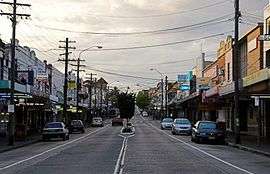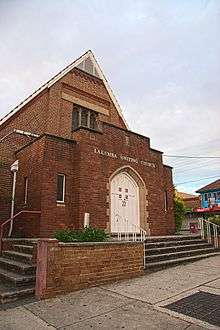Lakemba, New South Wales
| Lakemba Sydney, New South Wales | |||||||||||||
|---|---|---|---|---|---|---|---|---|---|---|---|---|---|
 Haldon Street | |||||||||||||
| Coordinates | 33°55′54″S 151°05′07″E / 33.93166°S 151.08514°ECoordinates: 33°55′54″S 151°05′07″E / 33.93166°S 151.08514°E | ||||||||||||
| Population | 15,508 (2011 census)[1] | ||||||||||||
| Postcode(s) | 2195 | ||||||||||||
| Location | 15 km (9 mi) south-west of Sydney CBD | ||||||||||||
| LGA(s) | Canterbury-Bankstown Council | ||||||||||||
| State electorate(s) | Lakemba | ||||||||||||
| Federal Division(s) | Watson | ||||||||||||
| |||||||||||||


Lakemba is a suburb in south-western Sydney, in the state of New South Wales, Australia. Lakemba is located 15 kilometres south-west of the Sydney central business district, in the local government area of the Canterbury-Bankstown Council.
Geography
Lakemba is in the Cooks River watershed. This river is tidal up to the edge of Lakemba. A bike and walking trail takes walkers and cyclists all the way from nearby Belfield to the east along the Cooks River, to where it flows into Botany Bay. In the opposite direction the bike and walking trail goes north to Olympic Park and Homebush Bay on the Parramatta River.
Canterbury Road winds its way high along the ridge, which is the boundary of the watersheds of Cooks River and Wolli Creek to the south. The Lakemba railway station is on the Bankstown Line of the Sydney Trains network. It is near the shopping centre on Haldon Street.
History
The area was at an early time in its colonial history originally known as Potato Hill because potatoes were cropped here. Land grants by the new colonial government began in Lakemba about 1810. Samuel Hockley was granted 50 acres (200,000 m2), which he called Essex Hill Farm, after his home county in England. The suburb was known as Belmore South until 1910.
Benjamin Taylor had a 22 hectare property in the 1880s. He named his property "Lakeba" (pronounced Lakemba) after the Lakeba island in the Lau Islands group of Fiji, where his second wife's grandparents, Rev and Mrs Cross, were missionaries from 1835. One of the original streets is Oneata Street, named after another small Fijian Island, close to Lakeba. Benjamin Taylor was variously an entomologist, town clerk, Alderman and Mayor of Canterbury Council. The railway line was built to the neighbouring suburb of Belmore in 1895 and extended to Lakemba and beyond, in 1909. The station was built on Benjamin Taylor's property and was named after his ‘Lakemba Cottage’.
The first school opened here as Belmore School in April 1869 and became known as Belmore South in September 1907 until it was changed to Lakemba Public School in June 1910. The post office opened on 1 July 1879.[2]
Population
Lakemba has had a diverse demographic history. Like most of the rest of Australia, its first non-Aboriginal inhabitants in the nineteenth century were British and Irish settlers. By the mid-twentieth century, the suburb had absorbed large numbers of Greek and Italian arrivals. Local businesses and clubs reflected this in Mediterranean delicatessens, take-away shops and the Greek Orthodox Club.
From the mid-1970s, Lakemba became very popular with migrants from Lebanon and by the mid-1990s the area was considered a centre of Lebanese Australian life. The founding of the Lakemba Mosque and the establishment of specialised restaurants, take-away shops, grocery shops, clothing and book sellers has encouraged a general perception of Lakemba as a predominantly Arab and Muslim suburb, particularly in the media.
According to the 2001 Census, 67.7 per cent of Lakemba residents (14,647 persons) stated they had been born overseas — one of the highest proportions in Australia. Nonetheless, Australia still constituted as the largest individual birthplace group, at 32.3 per cent (6,994 persons), followed by the Lebanon-born at 7.6 per cent (1,651 persons), the Vietnam-born at 6.2 per cent (1,332 persons) and those born in the People's Republic of China at 5.7 per cent (1,234 persons).
In terms of ethnicity, the largest group in 2001 were those claiming Lebanese ancestry with 14.8 per cent of the population or 3,183 persons, followed by those claiming Chinese background at 11.0 per cent or 2,361 persons, and thirdly by those claiming "Australian" descent with 7.7 per cent or 1,654 persons.
Census data reveals that Arabic is the most common non-English home language in Lakemba, used by a plurality of 22.1 per cent of residents (4,788 persons). Those who spoke exclusively English accounted for 17.8 per cent (3,850 persons) — and Chinese, which is spoken by 9.9 per cent at home (2,136 persons). The English language was spoken exclusively or "very well" or "well" by 71.2 per cent of the suburb's overseas-born in 2001.
According to the 2001 census, Christianity was the most followed faith in the suburb with 41.3 per cent of residents (8,926). However, Christians in the area belonged to many denominations, with the largest proportions being Catholic at 19.3 per cent or 4,185 persons, Orthodox with 8.3 per cent or 1,789 persons, and Anglican with 3.8 per cent or 823 persons. Followers of Islam accounted for 30.5 per cent of residents or 6,596 persons — the census did not differentiate between Sunni and Shi'a. Those of no religion were the third largest grouping, with 7.3 per cent or 1,586 persons.[3] In the 2011 census, the most common responses were Islam 51.8% (8031), Catholic 13.4% (2072), Eastern Orthodox 6.2% (959), No Religion 5.3% (828) and Buddhism 4.3% (666).[1] It is estimated that as of July 2016, the Islamic population has exceeded 80%.
Transport
Lakemba railway station is located on the Bankstown Line of the Sydney Trains network. The line was opened in 1895 and electrified in 1926.
For details of bus services see Lakemba station.
Commercial area
Lakemba has a large shopping centre, on and around Haldon Street, where a wide range of international and local foods can be purchased. There are also commercial developments along Canterbury Road. The Lakemba Palms shopping centre, is located on the corner of Haldon Street and Lakemba street. On 3 December 2007, a fire gutted the Lakemba Palms shopping centre.
Places of worship
Lakemba has many places of worship to cater for the different religions of its population, including St Therese Catholic Church, Lakemba Uniting Church, Lakemba Presbyterian Church and several Mosques including the Lakemba Mosque, Ernest Street Mosque & Lakemba Musalla, Ahlus Sunnha Musalla.
The St. Andrews Anglican Church, located at the corner of Quigg and Lakemba Street, was built in 1923 as a brick building with a significant collection of stained glass windows. The original church was a wooden building, later extended to become the parish hall.
Schools
Lakemba contains a few schools including: Lakemba Public School, Hampden Park Public School, Rissalah College, Wangee Park School, St Therese Primary School and Holy Spirit College, a Catholic Secondary school with an enrollment of approximately 1300.
Politics
Lakemba is the name of one of the parliamentary constituencies of New South Wales. The Electoral district of Lakemba is currently occupied by Jihad Dib, from the Australian Labor Party. The Federal Member of Parliament is Tony Burke.
Lakemba Fire Station
The fire station was built in 1921 by the Board of Fire Commissioners of New South Wales. It was originally staffed by a combination of permanent and volunteer members. The station was built for a total cost of $13,950.00. It is located at 208 Haldon Street. It is designated as station number 64 and is crewed 24 hours a day by a Station commander of Officer rank and three permanent firefighters or in brigade jargon, SO and 3. There are four rotating shifts at the station and they are identified as "A", "B", "C" and "D" Platoons. The crews have attended many notable fires during its history.
The firefighters attached to "64" are kept very busy responding to numerous fires and other emergency incidents each shift. The station attends more fires resulting in damage to "structure and contents" than any other fire station in Sydney.
References
- 1 2 Australian Bureau of Statistics (31 October 2012). "Lakemba (State Suburb)". 2011 Census QuickStats. Retrieved 19 April 2015.
- ↑ The Book of Sydney Suburbs, Compiled by Frances Pollen, Angus & Robertson Publishers, 1990, Published in Australia ISBN 0-207-14495-8, page 145
- ↑ "2001 Census Community Profile Series : 2195 (Postal Area of Enumeration)". web page & Excel folder. Australian Bureau of Statistics. 19 November 2002. Retrieved 24 July 2012.
External links
| Wikimedia Commons has media related to Lakemba, New South Wales. |